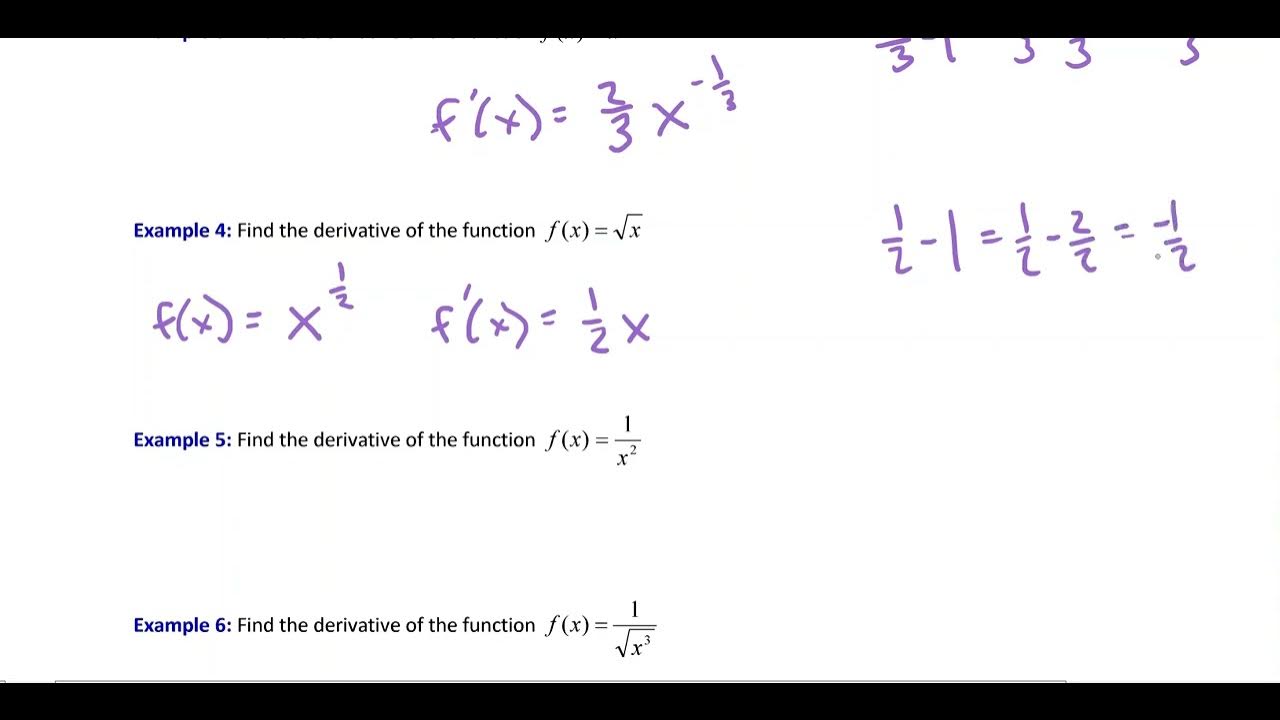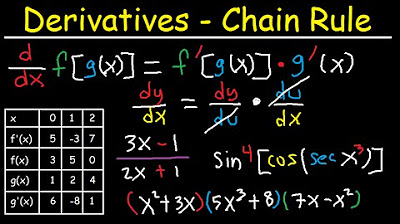Exercises on Derivative Rules — Topic 56 of Machine Learning Foundations
TLDRThis video script focuses on the application of derivative rules in calculus, specifically the constant rule, power rule, constant multiple rule, and sum rule. The content is structured around five exercises designed to test and reinforce understanding of these rules. The exercises progress in complexity, starting with the differentiation of a simple function and culminating in calculating the slope of a function at specific points using the derivative rules. The video also revisits a problem previously solved using the delta method, now employing derivatives to achieve the same result. The final exercise involves calculating the slope at two different points, tying together different approaches to identifying derivatives. The script concludes with a teaser for a more in-depth exploration of calculus, including advanced rules like the chain rule, in a Udney course on machine learning and data science foundations.
Takeaways
- 📚 The video script covers the application of basic derivative rules, including the power rule, constant multiple rule, and sum rule.
- 🔢 The first exercise involves differentiating the function y = -5x^3, resulting in the derivative -15x^2.
- 📈 The second exercise is a differentiation problem that yields the result 4x + 2.
- 🔍 The third exercise is more complex, involving multiple terms, and results in the derivative 50x^4 - 18x^2 - 1.
- 📝 For exercise four, the derivative rules are applied to find the slope of a function at x = 2, which is 6.
- ➡️ Exercise five involves calculating the slope at x = -1 using the same function and derivative from exercise four, resulting in a slope of zero.
- 🔧 The delta method was previously used to solve the same problems in the series, and the video encourages using derivative rules to achieve the same answers.
- 🤔 The video suggests that understanding these basic derivative rules is essential before moving on to more advanced rules like the chain rule.
- 📈 The product rule is mentioned as the next topic to be covered after the basic rules.
- 📚 The speaker provides a resource for a detailed walkthrough of the exercises, which is a course on Udemy called 'Machine Learning and Data Science Foundations'.
- 💡 The script emphasizes the importance of practicing derivative rules to solidify understanding and prepare for more complex concepts in machine learning.
Q & A
What are the basic derivative rules mentioned in the transcript?
-The basic derivative rules mentioned are the derivative of a constant, the power rule, the constant multiple rule, and the sum rule.
What is the result of differentiating y equals negative 5x cubed?
-The derivative of y = -5x^3 is -15x^2.
What is the general approach to differentiate a function using the sum rule?
-The sum rule states that the derivative of a sum of functions is the sum of the derivatives of the individual functions.
How does the power rule apply to the differentiation of x to the power of n?
-The power rule states that the derivative of x^n (where n is a constant) is n*x^(n-1).
What is the constant multiple rule in differentiation?
-The constant multiple rule states that the derivative of a constant times a function is the constant times the derivative of the function.
What is the purpose of exercise four in the transcript?
-Exercise four asks to find the slope of a function that has been previously encountered in the machine learning foundation series, specifically when x equals 2.
How is the delta method different from using derivative rules to find the slope of a function?
-The delta method is a numerical approach to estimate the slope or sensitivity of a function at a point, whereas using derivative rules is an analytical method that provides an exact expression for the slope.
What is the derivative found in exercise four of the transcript?
-The derivative found in exercise four is 2x + 2.
What is the slope of the function at x equals -1 as per exercise five?
-The slope of the function at x equals -1 is zero.
What advanced derivative rule is introduced after the basic rules in the transcript?
-After the basic rules, the transcript mentions moving on to the product rule and subsequently the chain rule.
What is the significance of practicing these derivative exercises in the context of machine learning?
-Derivative exercises are significant in machine learning as they form the mathematical foundation for understanding optimization algorithms and gradient descent methods.
Where can one find a detailed walkthrough of the solutions to the exercises presented in the transcript?
-A detailed walkthrough of the solutions can be found in the Udemy course called 'Machine Learning and Data Science Foundations'.
Outlines
📚 Derivative Rules Application Exercises
The paragraph introduces five exercises designed to test the understanding of various derivative rules, such as the power rule, constant multiple rule, and sum rule. The exercises progress in complexity, starting with differentiating a simple function like y = -5x^3, and moving on to more complex functions with additional terms. The exercises aim to provide practice in applying these rules and reinforce the concept of derivatives in the context of machine learning foundations.
Mindmap
Keywords
💡Derivative
💡Power Rule
💡Constant Multiple Rule
💡Sum Rule
💡Slope
💡Machine Learning Foundation Series
💡Delta Method
💡Product Rule
💡Chain Rule
💡Udemy Course
💡Differentiation Exercises
Highlights
Understanding of derivative rules is tested through five exercises combining the power rule, constant multiple rule, and sum rule.
The first exercise involves differentiating y = -5x^3.
Subsequent exercises add more terms to the differentiation problems for increased complexity and practice.
Exercise four requires finding the slope of a function at x = 2 using paper and pencil, derivative rules, and relates to a machine learning foundation series.
The same function from exercise four is used in exercise five, calculating the slope at x = -1.
The exercises aim to tie together different approaches for identifying derivatives.
Solution one yields -15x^2 for the differentiation of y = -5x^3.
Solution two results in 4x + 2 for its respective differentiation problem.
Solution three gives 50x^4 - 18x^2 - 1 after applying the derivative rules.
The derivative of the function for exercises four and five is calculated to be 2x + 2.
The slope of the function at x = 2 is found to be 6.
At x = -1, the slope of the function is zero.
The video prepares learners to move on to more advanced derivative rules, including the chain rule.
The product rule is introduced before the chain rule.
A detailed walkthrough of the solutions is available in the Udemy course 'Machine Learning and Data Science Foundations'.
The exercises are designed to be fun and engaging while reinforcing the understanding of derivative rules.
The use of the delta method is mentioned as a previous method for solving the same problem.
The importance of practicing with different x values to understand the behavior of the derivative at various points is emphasized.
The transcript is part of a machine learning foundation series, indicating a broader context for the mathematical concepts.
Transcripts
5.0 / 5 (0 votes)
Thanks for rating:





